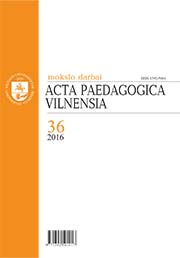Oficialusis ir neoficialusis diskursas: matoma ir nematoma mokyklos kultūra
Official and non-official discourse: visible and invisible school culture
Author(s): Šarūnė NagrockaitėSubject(s): Communication studies, School education, Sociology of Culture, Sociology of the arts, business, education, Present Times (2010 - today)
Published by: Vilniaus Universiteto Leidykla
Keywords: school culture; formal and informal discourse; discourse analysis; space of communication;
Summary/Abstract: The article presents school culture, which is recognised through its discourse. The focus is laid on formal and informal discourse as an expression of school culture. Analysing the discourse, the article aims to identify cultural expression of school among its different groups (school administration, teachers and learners). The division between the “Big ‘D’ Discourse” and “little-d discourse” introduced by P. J. Gee (2011) is employed in the work. These notions represent formal and informal discourses. Official discourse refers to everything that determines and makes a social group or its network recognisable and is ascribed to the mainstream social group, which is in charge of the preservation of this discourse. This is expressed using various ways that create identity and representation of the prevailing social group. On the other hand, “little-d discourse” expands or changes the formal discourse and, thus, Gee, J. P.; Handford, M. (Eds). New York and London: Routledge, p. 9–20. Fairclough, N. (2010). Critical Discourse Analysis: The Critical Study of Language. New York and London: Routledge. Foucault, M. (1998). Diskurso tvarka. Vilnius: Baltos lankos. Gee, P. J.; Handford, M. (2013). Introduction. The Routledge Handbook of Discourse Analysis (Routledge Handbooks in Applied Linguistics) Gee, J. P.; Handford, M. (Eds.). New York and London: Routledge, p. 371–382. OFFICIAL AND NON-OFFICIAL DISCOURSE: VISIBLE AND INVISIBLE SCHOOL CULTURE Šarūnė Nagrockaitė Summary creates a new, different and informal discourse. (Gee, 2010). The “little-d discourse” does not perform a direct representative function but it is capable of supplementing the formal discourse or opposing and criticising it. The analysis of the discourse is grounded not only on the ideas of P. J. Gee (2010, 2011, 2013), a researcher in sociolinguistic discourse analysis, but also on those of N. Fairclough (2010, 2013) and M. Foucault (1998), the representatives of critical discourse analysis. The article is mainly based on the data of empiric qualitative research conducted in the period of 2014–2015, which aimed to investigate school culture at various crosssections (space, time, artefacts, rituals and course as communication).
Journal: Acta Paedagogica Vilnensia
- Issue Year: 2016
- Issue No: 36
- Page Range: 59-71
- Page Count: 13
- Language: Lithuanian

